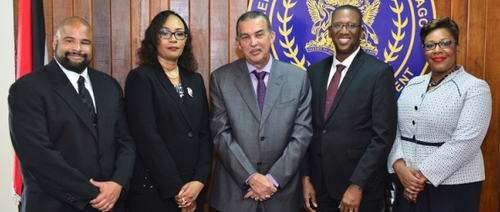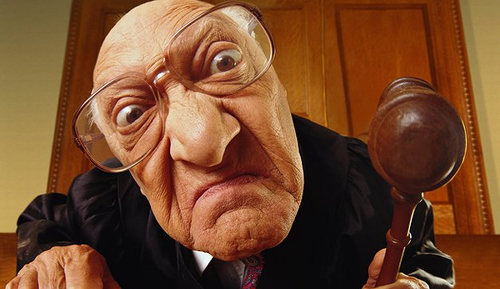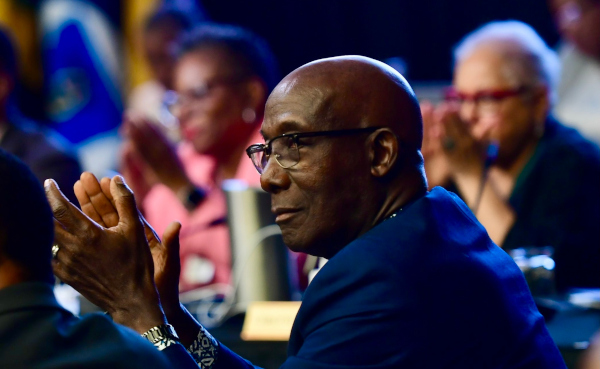It is difficult to move away from the current controversies swirling around the judiciary. With the revelation, last Sunday, of Mrs Marcia Ayers-Caesar’s version of what took place between her and the Chief Justice regarding unfinished cases—part-heard matters—the plot has thickened.
It is now common ground that on the evening of April 10th Marcia presented a list of part-heard matters to the Chief Justice, which he read. What is unclear is what the list contained.

Also in the photo is Chief Justice and JLSC chairman Ivor Archie.
Ayers-Caeser subsequently resigned on the instruction of the JLSC.
In one of its press statements the Judicial and Legal Services Commission (JLSC) stated that the list did not describe the matters or disclose that witnesses that had already given evidence in some of the cases on the list. The JLSC gave no indication of the number of matters on the list.
Marcia, on the other hand, says that there were 28 matters on that list. If that is so, it is difficult to understand why the revelation of a significant number of matters did not cause the JLSC to mash brakes on Marcia’s swearing in as a High Court Judge.
This becomes more inexplicable in circumstances where it was the further disclosure that the part-heard matters numbered 52 that caused the Chief Justice to hustle down obtaining Marcia’s resignation from her appointment as a High Court Judge.
It seems obvious to me that, from the moment it became known to the Chief Justice from the presentation of the list that, whatever their nature, there were more part heard cases than those which Marcia had disclosed in her prior oral representation, additional due diligence was required.
Alleged lack of availability of records has come into sharper focus as a result of reading Marcia’s side of the story. She said that she was able to “discover” that she had 28 part heard matters by making inquiries of the Note Taking Unit of the Magistracy. She also claimed that she was able to obtain the information within 24 hours.

(Copyright News.gov.tt)
Meanwhile the tweets of another appointee from the round of controversial appointments became front page news. The references to the female anatomy are offensive when assessed by current standards of the respect to be shown to women. The tweets have a distinctly Trump-ish flavour.
I was aware that current due diligence practices include a search of the social media posts of prospective employees. Internet research suggests that 60 percent of employers in the United States do this as well as many Universities.
Some apologists for the JLSC are declaring that criticism of the Chief Justice is politically or racially driven. That is inevitable in a divided society like ours. It is important therefore to emphasise why unaligned commentators are pursuing the disastrous results of flawed High Court appointments.
High Court appointments effectively give security of tenure for the life of the appointee. The grounds for removal of a Judge are restrictive and subject to a cumbersome removal process. Judges exercise some of the most coercive powers of the State and routinely make decisions about the life, liberty and property of citizens. These decisions have far reaching consequences on the lives of citizens, both on those before the Court and on their families and their businesses or occupation.
Given the current trend of appointing Judges at relatively early ages, some of our Judges exercise these awesome powers for upwards of 15 years.

(Copyright Baloo)
In the circumstances outlined above, there is a huge risk factor to be managed in the course of the appointment process. Any so-called rigorous process must involve risk management techniques.
I made a number of the points contained in this column in two television interviews last week. I showed mirth at some of the questions put to the candidates for judicial appointments, presumably to test their capacity for logic.
The questions were described by one newspaper as bat and ball questions because one of them required the candidate to deduce the difference in cost between a bat and a ball to which cost factors were ascribed.
I referred to our love for fads when adopting some practices from abroad not relevant to our culture. One newspaper reported my remarks as dismissive of a love for “bats” not of the fads to which I was referring.
From a comic perspective, reference to “bats” might be transferred from the sporting implement context to the old English expression “bats in the belfry.”
The expression refers to the occupation by bats of English bell towers, also known as belfries, and their erratic flying around in the bell towers. Bats in the belfry refers to someone who acts as though he has bats flying around erratically in his head.

By contrast, the country requires judicial heads to be clear. We must continue therefore to pursue the failure of the JLSC to apply the highest standards to the appointments of judicial officers, who acquire a constitutional status of near untouchable.
Let’s not use bats and fads for the purpose of appointments.
 Wired868 Wired868 for smart sport news and opinion
Wired868 Wired868 for smart sport news and opinion









Embedded in the Parliamentary System of government is “Winner takes All’ which ensures division in T&T. The appointment of friends and family to the Judiciary and other institutions are a norm in T&T If the Constitution is not amended to address such issues, we shall continue the cycle. Mind you qualified and competent people can be appointed to high offices if we have mature people who are independent thinkers . Lack of implementation of rules, regulations and policies by inept people holding positions make then believe that they are ”untouchable’. People who have morals, ethics and integrity are the ones who don’t enter the nasty games of politics or high office
“the country requires judicial heads to be clear. We must continue therefore to pursue the failure of the JLSC to apply the highest standards to the appointments of judicial officers, who acquire a constitutional status of near untouchable.” Or perhaps they should not be so untouchable…
I wonder what reasonable perimeters you can create to gauge their performances on without making judges vulnerable to political or public pressure…
Magistrates and judges have their performance reviewed constantly by superior courts.if that is not reasonable, and I do not know what is. Criticism from a superior court can tarnish a judge’s reputation – I recall the Privy Council saying that Volney “went off on a frolic of his own”. This is quite a harsh criticism in judicial language.
You would need to have more than just a basic idea of the rule of law, And the separation of powers to understand the importance of judicial independence. The typical layman lacks this knowledge.
A bat and ball cost $1.10.
The bat costs one dollar more than the ball.
How much does the ball cost?
A number came to your mind. The number, of course, is 10: 10¢. The
distinctive mark of this easy puzzle is that it evokes an answer that is
intuitive, appealing, and wrong. Do the math, and you will see. If the ball
costs 10¢, then the total cost will be $1.20 (10¢ for the ball and $1.10 for
the bat), not $1.10. The correct answer is 5¢. It is safe to assume
that the intuitive answer also came to the mind of those who ended up with
the correct number—they somehow managed to resist the intuition.
Shane Frederick and I worked together on a theory of judgment based
on two systems, and he used the bat-and-ball puzzle to study a central
question: How closely does System 2 monitor the suggestions of System
1? His reasoning was that we know a significant fact about anyone who
says that the ball costs 10¢: that person did not actively check whether the
answer was correct, and her System 2 endorsed an intuitive answer that it
could have rejected with a small investment of effort. Furthermore, we also
know that the people who give the intuitive answer have missed an obvious
social cue; they should have wondered why anyone would include in a
questionnaire a puzzle with such an obvious answer. A failure to check is
remarkable because the cost of checking is so low: a few seconds of
mental work (the problem is moderately difficult), with slightly tensed
muscles and dilated pupils, could avoid an embarrassing mistake. People
who say 10¢ appear to be ardent followers of the law of least effort. People
who avoid that answer appear to have more active minds.
Many thousands of university students have answered the bat-and-ball
puzzle, and the results are shocking. More than 50% of students at
Harvard, MIT, and Princeton gave the intuitive—incorrect—answer. At
less selective universities, the rate of demonstrable failure to check was in
excess of 80%. The bat-and-ball problem is our first encounter with an
observation that will be a recurrent theme of this book: many people are
overconfident, prone to place too much faith in their intuitions. They
apparently find cognitive effort at least mildly unpleasant and avoid it as
much as possible.
From “Thinking, Fast and Slow” by Daniel Kahneman
A lot of commentators criticize the numeracy aspect of the selection process. However, considering that there is a public service analysis unit that works with numbers on a daily basis whose members cannot do basic algebra and that maths is shunned by many law students, I would not be so dismissive of the SEA questions. Not to mention the fact that a large portion of the population cannot represent five cases containing twenty four bottles mathematically.